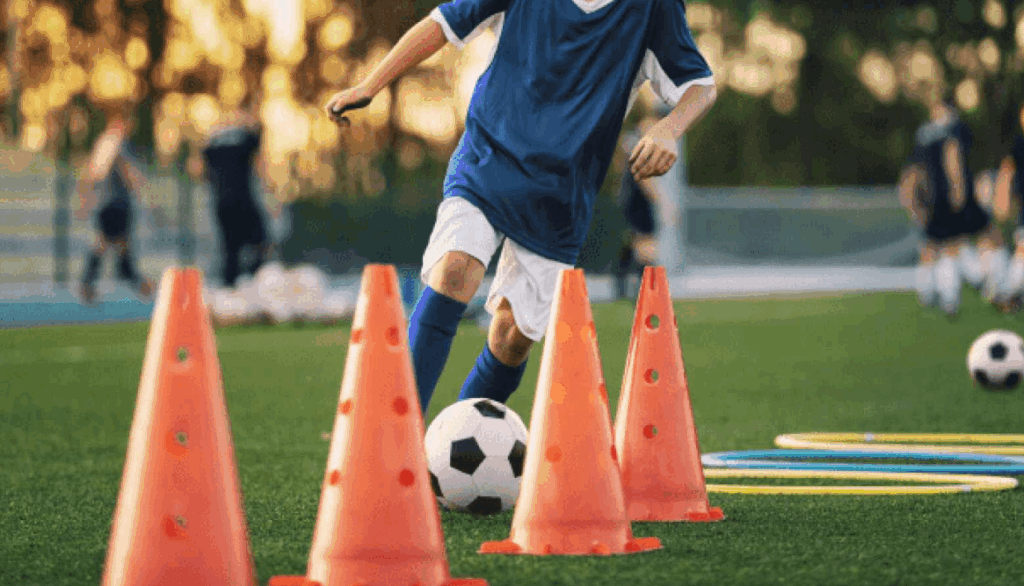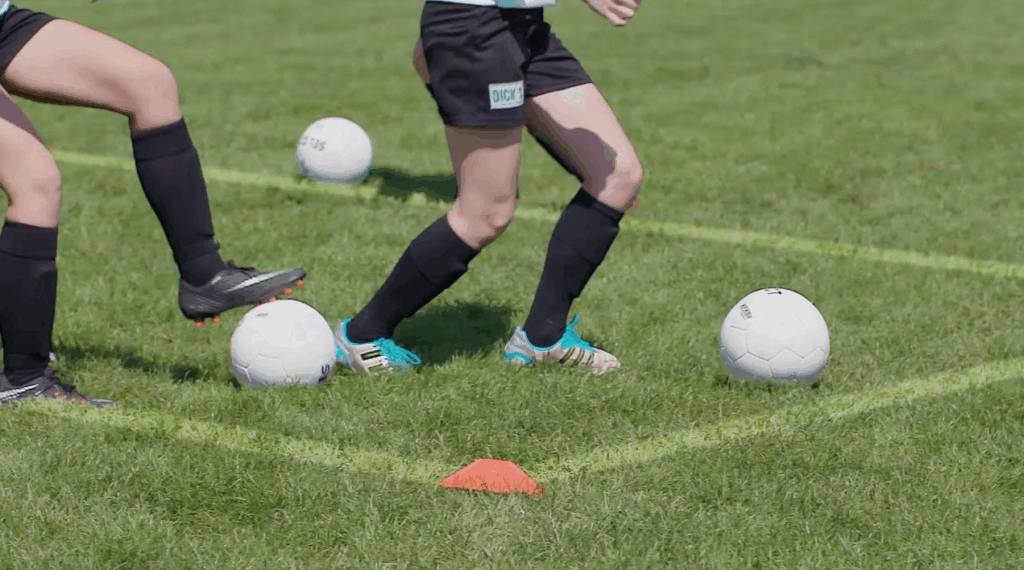To get better at controlling the soccer ball, try cone weaving (moving through zigzag cones two feet apart), figure-eight patterns (dribbling around two cones using the right foot technique), box drill (doing certain turns at four corner cones), one-touch wall work (practicing clean rebounds from wall passes), and pressure dribbling (keeping the ball while a partner follows you).
Start slowly and then speed up as you get better at each technique. These basics will change how confident and well you play on the field.
Cone Weaving Challenge for Tight Control
The cone weaving challenge is different from most drills because it focuses on controlling the ball perfectly in small spaces. Put eight cones in a zigzag pattern, with each cone about two feet apart. Your job is to get through without hitting any cones.
Start slowly, using the inside and outside of both feet to maneuver the ball. As your confidence builds, gradually decrease the space between cones to intensify the difficulty. These cone drills develop your ability to change direction quickly while maintaining close control.
Set a timer or race against your teammates to make it even harder. Remember that it’s better to move slowly and with perfect form than to rush and lose control. This drill is very similar to what you need to do in a game when you have to get past defenders in tight spaces.

Figure-Eight Drill to Enhance Direction Changes
The figure-eight drill builds on the control skills developed in cone weaving, but focuses specifically on fluid direction changes at speed. You’ll need just two cones placed about 5 yards apart to create a challenging workout for your dribbling skills.
Start by dribbling around both cones in a figure-eight pattern, using the outside of your foot when turning away from the cone and the inside of your foot when turning toward it. Begin slowly to master the technique, then gradually increase your pace.
This drill makes you practice quickly changing direction while keeping close control. Try switching between using only your stronger foot for 30 seconds and only your weaker foot. This balanced way of playing helps players develop the ambidextrous touch they need to win games.

Mastering Quick Turns of Box Drill
To elevate your turning abilities, a box drill provides an exceptional framework for developing rapid directional changes under control. Set up four cones in a square formation about 5 yards apart. Start at one cone, dribble to the next, then perform a specific turn. Do inside cut, outside hook, or Cruyff, before heading to the next cone.
Focus on maintaining tight ball control throughout each turn, keeping your touches small and your head up. This drill sharpens your agility training while simulating game situations where quick direction changes are essential.
For added difficulty, decrease the box size or add a passive defender. Practice regularly at high intensity for 5-minute intervals, ensuring you work both clockwise and counterclockwise to develop balanced turning abilities with both feet.

One-Touch Wall Work for Precision Control
One-touch wall drills are a great way to improve your ball control skills because they go from dynamic turning exercises to precision work. To get a lot better at your first touch, all you need is a wall and a ball that you use over and over again.
Stand 5-7 feet from the wall and pass the ball with varying levels of power, focusing on receiving the rebound with a clean, controlled touch. As your ball mastery improves, alternate between feet, inside and outside surfaces, and even incorporate volleys to challenge yourself further.
For advanced progression, mark specific targets on the wall to improve accuracy. Try maintaining a continuous rhythm of passes for 30-60 seconds without losing control. This seemingly simple exercise builds the muscle memory essential for precise ball handling during high-pressure game situations.
Pressure Dribbling With Defensive Shadows
Training alone with a wall can help you improve your technical skills, but dribbling under pressure with defensive shadows takes your skills to the next level. This technical training simulates defenders without full contact, which lets you focus on keeping control when things get tough.
To practice, find a teammate who will follow you around without tackling you. You’ll dribble in a defined area while they mirror your position, forcing you to use body feints and quick direction changes to create space.
Start with passive shadows, maintaining a 2-3 feet distance, then gradually increase the difficulty by allowing defenders to get closer. Work on scanning the field while dribbling and vary your speed to throw off the shadow defender’s timing. This drill develops your composure and decision-making when opponents close you down.
Frequently Asked Questions
How Do Weather Conditions Affect Dribbling Technique and Ball Control?
Adjust your technique in wet conditions by using lighter touches. Wind requires stronger control, while heat slows ball movement. Cold weather makes the ball harder and less responsive.
Can Ankle Weights Improve Dribbling Strength and Control During Practice?
While you can use ankle weights sparingly to build strength, they’ll often compromise your technique and may increase injury risk. You’ll develop better control through proper technique drills without added weight.
At What Age Should Children Start Specialized Dribbling Training?
You can begin basic dribbling training as early as 4-6 years old, but specialized technical training works best around 8-10 years, when children’s coordination develops more fully. Start simple and progress gradually.
How Does Playing Surface Impact Dribbling Drill Effectiveness?
Playing surfaces greatly affect your drills. You’ll develop better technical control on smooth surfaces, while rough terrain builds strength and adaptability. Indoor courts enhance precision, while natural grass mimics game conditions you’ll face in matches.
What Mental Techniques Help Players Maintain Focus During Complex Dribbling Sequences?
Before each sequence, picture yourself succeeding, positively talk to yourself, and break drills into smaller parts. Setting small goals, controlling your breathing, and staying present during each movement will help you stay focused.





